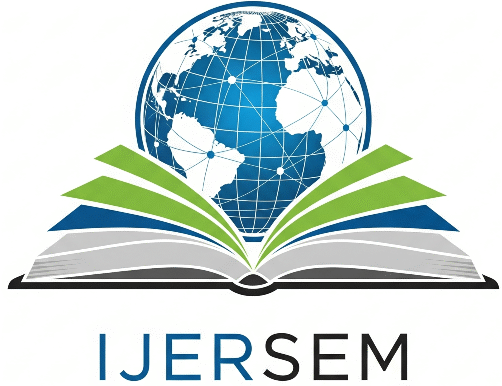International Journal of Emerging Research in Science, Engineering, and Management
Vol. 1, Issue 4, pp. 19-26, October 2025.
This work is licensed under a Creative Commons Attribution 4.0 International License.
Study of Thermal Conductivity Enhancement in Nanofluids Containing Metal Oxide Nanoparticles
Baby Theresa
Ambati Syamala
Assistant Professor, Department of Mechanical Engineering, Hyderabad Institute of Technology and Management, Hyderabad, India
Abstract: Nanofluids have emerged as advanced heat transfer media with significantly improved thermal performance compared to conventional fluids. This paper investigates the enhancement of thermal conductivity in nanofluids containing metal oxide nanoparticles, emphasizing the influence of particle type, size, shape, concentration, and interfacial interactions on overall heat transport behavior. A comprehensive literature synthesis demonstrates that the molecular structure and surface modification of nanoparticles directly govern thermal conductivity and stability. Recent molecular dynamics studies have shown that Cu-H₂O nanofluids exhibit higher thermal conductivity than CuO-H₂O counterparts, due to stronger phonon coupling at the solid–liquid interface and lower viscosity. Experimental works on hybrid and bio-based nanofluids further highlight the role of cellulose nanocomposite templates and surface functionalization in improving particle dispersion and dynamic stability. Additionally, investigations of rare-earth and Fe₃O₄@graphene oxide nanofluids reveal that synergistic interactions among nanoparticles can yield up to 270% heat transfer enhancement, surpassing that of single-component systems. Numerical and computational analyses of various metal oxide–based nanofluids (e.g., Al₂O₃, ZnO, TiO₂, MgO, and SiO₂) confirm that thermal conductivity improvement is strongly correlated with Reynolds number, nanoparticle surface area-to-volume ratio, and interfacial layer density. The study concludes that optimizing nanoparticle morphology, hybridization strategy, and surfactant-assisted stabilization offers a promising pathway for achieving high-efficiency, durable nanofluids suitable for solar thermal, photovoltaic cooling, and industrial heat exchanger applications.
Keywords: Nanofluids, Metal oxide nanoparticles, Thermal conductivity, Molecular dynamics simulation, Hybrid nanofluids, Phonon coupling.
References:
- S. Lee, S. U. S. Choi, S. Li, and J. A. Eastman, “Measuring thermal conductivity of fluids containing oxide nanoparticles,” J. Heat Transfer, vol. 121, no. 2, pp. 280–289, 1999, doi: 10.1115/1.2825978.
- S. U. S. Choi and J. A. Eastman, “Enhancing thermal conductivity of fluids with nanoparticles,” ASME Int. Mech. Eng. Congress and Exhibition, San Francisco, USA, 1995.
- S. K. Das, N. Putra, and P. Thiesen, “Temperature dependence of thermal conductivity enhancement for nanofluids,” J. Heat Transfer, vol. 125, pp. 567–574, 2003, doi: 10.1115/1.1571080.
- H. Xie, J. Wang, T. Xi, and Y. Liu, “Thermal conductivity of suspensions containing nanosized alumina particles,” Int. J. Thermophys., vol. 23, no. 2, pp. 571–580, 2002, doi: 10.1023/A:1015121805842.
- M. S. Liu, M. C. Lin, I. T. Huang, and C. C. Wang, “Enhancement of thermal conductivity with CuO for nanofluids using chemical reduction method,” Int. J. Heat Mass Transfer, vol. 49, no. 17, pp. 3028–3033, 2006, doi: 10.1016/j.ijheatmasstransfer.2006.02.007.
- R. S. Vajjha and D. K. Das, “Experimental determination of thermal conductivity of three nanofluids and development of new correlations,” Int. J. Heat Mass Transfer, vol. 52, no. 21, pp. 4675–4682, 2009, doi: 10.1016/j.ijheatmasstransfer.2009.06.027.
- J. Buongiorno, “Convective transport in nanofluids,” J. Heat Transfer, vol. 128, no. 3, pp. 240–250, 2006, doi: 10.1115/1.2150834.
- X. Wang and A. S. Mujumdar, “Heat transfer characteristics of nanofluids: a review,” Int. J. Therm. Sci., vol. 46, no. 1, pp. 1–19, 2007, doi: 10.1016/j.ijthermalsci.2006.06.010.
- Y. Li, J. Zhou, S. Tung, and E. Schneider, “A review on development of nanofluid preparation and characterization,” Powder Technol., vol. 196, no. 2, pp. 89–101, 2009, doi: 10.1016/j.powtec.2009.07.025.
- P. K. Namburu, D. P. Kulkarni, A. Dandekar, and D. K. Das, “Experimental investigation of viscosity and thermal conductivity of hybrid Al₂O₃ + CuO nanofluids,” Micro Nano Lett., vol. 2, no. 3, pp. 67–71, 2007, doi: 10.1049/mnl:20070037.
- L. S. Sundar, M. T. Naik, K. V. Sharma, and M. K. Singh, “Experimental investigation of Fe₃O₄ nanofluid on heat transfer enhancement under turbulent flow,” Int. Commun. Heat Mass Transfer, vol. 44, pp. 7–14, 2013, doi: 10.1016/j.icheatmasstransfer.2013.03.015.
- J Philip and P. D. Shima, “Thermophysical properties of nanofluids containing oxide nanoparticles: Influence of particle size and shape,” J. Nanosci. Nanotechnol., vol. 12, no. 5, pp. 4014–4021, 2012, doi: 10.1166/jnn.2012.6031.
